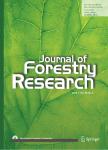Responses of radial growth, wood density and fiber traits to planting space in poplar plantations at a lowland site
Responses of radial growth,wood density and fiber traits to planting space in poplar plantations at a lowland site作者机构:College of ForestryNanjing Forestry UniversityNanjing210037People’s Republic of China Co-Innovation Center for Sustainable Forestry in Southern ChinaNanjing Forestry UniversityNanjing210037People’s Republic of China
出 版 物:《Journal of Forestry Research》 (林业研究(英文版))
年 卷 期:2022年第33卷第3期
页 面:963-976页
核心收录:
学科分类:0907[农学-林学] 08[工学] 0829[工学-林业工程] 09[农学]
主 题:Planting density Growth ring Fiber morphology Chemical composition Temporal-spatial variation
摘 要:Poplar is raw material for various panel, paper and fiber products. The 12 sample trees of clone Nanlin-895 from four spacings were destructively harvested after thirteen growing seasons to assess the influence of spacing on radial growth and wood properties. Spacing significantly affected tree-ring width and wood basic density (p 0.05) but not fiber traits. The highest diameter and wood basic density at breast height (1.3 m) was in 6 m × 6 m and 3 m × 8 m spacings, respectively. However, no significant differences in tree-ring width, wood basic density and fiber traits were observed among the four sampling directions in discs taken at 1.3 m for each spacing. Growth rings from the pith and tree heights had significant effects on wood basic density and fiber anatomical characteristics, highlighting obvious temporal-spatial variations. Pearson correlation analysis showed a significantly negative relationship of tree-ring width to wood basic density, fiber length and fiber width, but a significantly positive relationship to hemicellulose. There was no relationship with cellulose and lignin contents. Based on a comprehensive assessment by the TOPSIS method, the 6 m × 6 m spacing is recommended for producing wood fiber at similar sites in the future.



